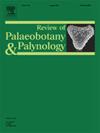Early Cretaceous vegetation in a polar ecosystem—Palynology and zircon dating of the Koonwarra Fossil Bed, Victoria, Australia
IF 1.7
3区 地球科学
Q2 PALEONTOLOGY
引用次数: 0
Abstract
The Early Cretaceous Koonwarra site, Victoria, Australia, comprises a fossil bed considered to be a Konservat Lagerstätte famous for its myriad of fossil fish, feathers, invertebrates, and plants. Here we provide a vegetation reconstruction based on detailed palynology from a 21 m long drill core of which the basal 10 m represents the Koonwarra Fossil Bed (KFB) proper. Palynological analysis of the KFB revealed well-preserved assemblages, and c. 30,000 palynomorphs were identified, representing 138 taxa. The palynoassemblages are dominated by gymnosperm pollen, especially Alisporites (‘seed-ferns’), Araucariacites (Araucariaceae), Podocarpidites (Podocarpaceae) and monosulcate grain producers (most possibly Ginkgoales and Pentoxylales). Minor constituents include Eucommidiites and various arborescent gymnosperm pollen, including those produced by Cheirolepidiaceae such as Classopollis. The next most abundant groups are the fern spores, followed by lycophyte spores, both of which constitute a substantial portion of the palynoflora. Angiosperm pollen represents a minor but important element of the flora throughout the succession (1–6%). The LAICP-MS U–Pb dating of detrital zircon grains bracketing the Koonwarra Fossil Bed reveal a maximum dominant age of ≤ 114.1 Ma (latest Aptian) but with a few younger grains dated at 110 Ma.
The palynological analysis tentatively ascribes a slightly younger age to the Unit, with assemblages referred to the very base of the Coptospora paradoxa Zone, signifying an early Albian age, based on the presence of the indices Coptospora paradoxa and Stoverisporites lunaris, combined with abundance data of various groups. Comparisons with coeval successions from other Southern Hemisphere localities, indicated that the Koonwarra assemblages derived from a cool temperate lake-margin vegetation.
极地生态系统中的早白垩世植被——澳大利亚维多利亚Koonwarra化石层孢粉学和锆石年代测定
澳大利亚维多利亚州的早白垩纪Koonwarra遗址包括一个被认为是Konservat的化石床Lagerstätte,以其无数的鱼类、羽毛、无脊椎动物和植物化石而闻名。在这里,我们提供了一个基于详细孢粉学的植被重建,从21米长的钻孔岩心中,基底10米代表Koonwarra化石层(KFB)。孢粉学分析显示,KFB的孢粉组合保存完好,鉴定出约3万个孢粉形态,代表138个分类群。孢粉组合以裸子植物花粉为主,尤其是阿里孢子虫(种子蕨类)、Araucariacites (araucariacaceae)、Podocarpidites (Podocarpaceae)和单根孢粉(最有可能是银杏和戊氧基)。次要成分包括真丝植物和各种乔木裸子植物的花粉,包括那些由Cheirolepidiaceae如Classopollis产生的花粉。其次最丰富的类群是蕨类孢子,其次是石松孢子,两者都构成了孢粉植物的很大一部分。被子植物花粉在整个演替过程中是一个次要但重要的组成部分(1-6%)。包覆Koonwarra化石层的碎屑锆石的LAICP-MS U-Pb定年结果显示,锆石的最大优势年龄≤114.1 Ma(最晚Aptian),但也有一些较年轻的锆石颗粒年龄为110 Ma。根据Coptospora paradoxa和Stoverisporites lunaris指标的存在,结合不同类群的丰富数据,孢粉学分析初步认为该单元的年龄略小,其组合参考了Coptospora paradoxa带的最底部,表明其年龄较早。与南半球其他地区的同期序列比较表明,Koonwarra组合来自于一个凉爽的温带湖缘植被。
本文章由计算机程序翻译,如有差异,请以英文原文为准。
求助全文
约1分钟内获得全文
求助全文
来源期刊
CiteScore
3.50
自引率
21.10%
发文量
149
审稿时长
6 months
期刊介绍:
The Review of Palaeobotany and Palynology is an international journal for articles in all fields of palaeobotany and palynology dealing with all groups, ranging from marine palynomorphs to higher land plants. Original contributions and comprehensive review papers should appeal to an international audience. Typical topics include but are not restricted to systematics, evolution, palaeobiology, palaeoecology, biostratigraphy, biochronology, palaeoclimatology, paleogeography, taphonomy, palaeoenvironmental reconstructions, vegetation history, and practical applications of palaeobotany and palynology, e.g. in coal and petroleum geology and archaeology. The journal especially encourages the publication of articles in which palaeobotany and palynology are applied for solving fundamental geological and biological problems as well as innovative and interdisciplinary approaches.

 求助内容:
求助内容: 应助结果提醒方式:
应助结果提醒方式:


